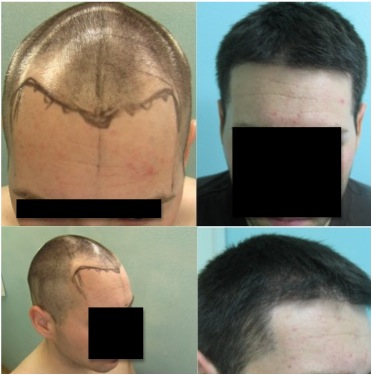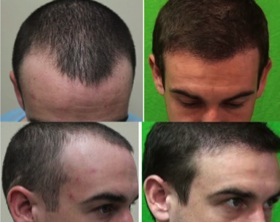
HAIR LOSS AT THE HAIRLINE
Hairline recession is specific to male pattern baldness (except in the case of traction alopecia, which commonly affects African American women). In the United States alone, more than 40 million men suffer from hair loss, with 95% of those cases caused by pattern baldness or androgenic alopecia. And the first physical manifestation of baldness ranked by the Norwood scale is hairline loss.
Male pattern baldness is inherited in the form of weak androgen receptors, carried by the mother’s and/or father’s X chromosomes. These weak androgen receptors cause scalp hair to be sensitive to dihydrotestosterone. Once DHT comes into contact with the genetically vulnerable follicle, it miniaturizes the follicle to destruction. Eventually, this leads to the typical r hairline recession and crown thinning.
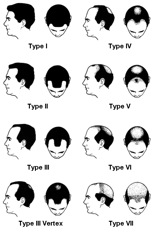
HAIRLINE RESTORATION
Successful hairline restoration not only restores hair, but also has the power to return confidence, happiness, and quality of life. Hairline loss can bring about powerful negative emotions, so when pursuing hair restoration it is important that a prospective patient get the best treatment possible to help ensure a successful outcome. The restoration techniques available are:
- Temporoparietal-occipital flap surgery
- Follicular unit transplant (FUT)
- Follicular unit extraction (FUE)
Flap surgery is an antiquated method, though still occasionally used. It cuts two flaps of skin on either side of the head and rotates them forward to be connected with the tissue along the hairline. This method is highly invasive, produces an unnatural-looking result, and has serious health risks like permanent nerve damage.
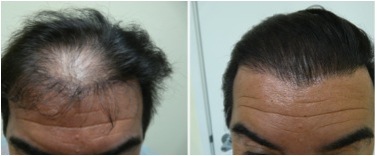
The two most common methods used to correct hairline recession are FUT and FUE, though FUE is inarguably the more sophisticated. FUT removes a linear strip of skin from the rear scale, which is later cut into implantable follicular units. FUE removes the grafts as follicular units directly from the scalp with a .8 to 1.2mm punch tool. FUE is considered a minimally invasive microsurgery and enables an advanced aesthetic because of its broader donor selection. While FUT is confined to the mid-rear scalp, where hair texture is thickest by nature, FUE can harvest hair from the nape of the neck or behind the ears, where hair has a finer texture. These finer hair create softer hairlines that appear much more natural than the harsh hairline creation of FUT.
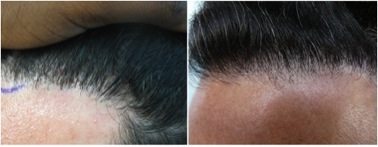
Furthermore, FUT leaves an inevitable strip scar that stretches out over time, often necessitating repair. FUE avoids the strip scar altogether and proffers only negligible scarring typically. A receding hairline has the best chance of a superior restoration through FUE, in the care of an advanced surgeon. Considerations for successful hairline design with FUE or FUT include shape, positioning, density and texture.
Receding Hairline : PHOTOS AND VIDEOS
Photos and videos of prior hairline restoration are an important guide in deciding the technique and surgeon you want to use. These images should clearly show the quality of the hairline design—what texture of hair was used, where the hairline was positioned, its shape, and its density; as well as how seamlessly the hairs change angle and direction to transition into the temple recesses on either side.
Poor quality images, poor results, or images that appear retouched signify a bad clinic. Worthwhile photos and videos always show the hairline result from the front, left, and right sides in good lighting and clear focus.
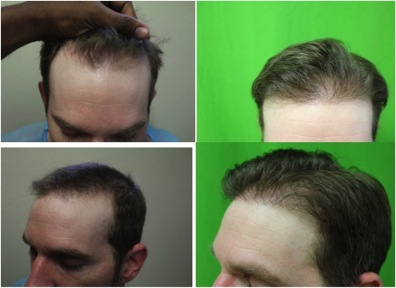
FAQ
I have a receding hairline. Am I a candidate for surgery?
This depends on a few things. You need to be over the age of 24 and have enough donor hair for adequate coverage. A history of irregularities with blood clotting, a propensity for scarring, or allergies to anesthesia will likely disqualify you from being a candidate.
Can people with curly hair have hairline restoration done?
Curly or kinked follicles are difficult to harvest and tend to raise transection rates, which could compromise the result. However, it is not impossible in the care of an advanced surgeon.
What is traction alopecia?
Traction alopecia is a loss of hair along the peripheral edges of the scalp, meaning the front and back hairlines and around the ears. Abrasively tight hairstyles that put a constant pulling force on the hair cause trauma and scarring to the scalp, resulting in this permanent hair loss condition. Common causative styles include cornrows, braids, weaves, extensions, and tight ponytails worn often or daily.
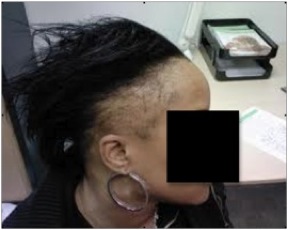
Here is a patient video which involves a successful hairline and crown reconstruction using 10,000 grafts. Click here to learn more and watch his before and after video.

